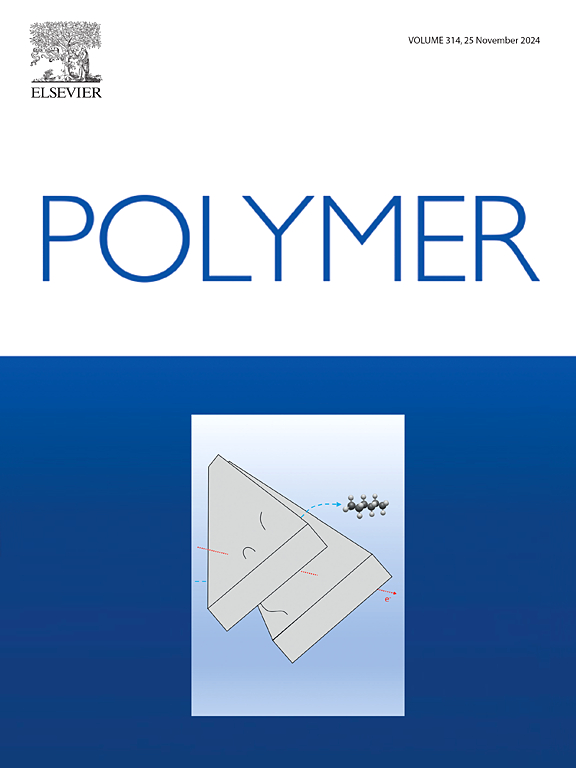Rheological analysis of chain extension reaction in PBAT-microalgae composite and its effect on film fabrication
IF 4.1
2区 化学
Q2 POLYMER SCIENCE
引用次数: 0
Abstract
In this study, we investigate the reaction of an epoxy-based chain extender in poly(butylene adipate-co-terephthalate) (PBAT) composites incorporating protein-rich microalgae, Chlorella sp. HS2. The chain extension reaction in the PBAT/HS2 system is systematically characterized using rheological and gel permeation chromatography analyses, showing that the addition of HS2 significantly changes reaction kinetics because HS2 induces PBAT degradation and also actively participates in the reaction with the chain extender. Under heat, the chain extender with epoxy functional groups actively reacts with degraded PBAT molecules through thermal decomposition and microalgae incorporation, restoring PBAT, while simultaneously facilitating interfacial bridging between PBAT and HS2. As the content of the chain extender increases, the chain extension reaction leads to a more structural evolution and induces molecular branching, resulting in strong shear thinning and strain hardening behavior. The effect of chain extension improves film processing of PBAT/HS2 composites. T-die extrusion demonstrated the feasibility of film production, emphasizing the industrial applicability of the newly formulated composites. The findings underscore the crucial role of advanced rheological strategies in characterizing reactive compatibilization between biodegradable polymers and natural fillers.

pbat -微藻复合材料扩链反应流变学分析及其对薄膜制备的影响
在这项研究中,我们研究了环氧基扩链剂在含有富含蛋白质的微藻,小球藻sp. HS2的聚己二酸丁烯-对苯二甲酸酯(PBAT)复合材料中的反应。通过流变学和凝胶渗透色谱分析对PBAT/HS2体系中的扩链反应进行了系统表征,结果表明HS2的加入显著改变了反应动力学,因为HS2诱导PBAT降解,并积极参与与扩链剂的反应。在高温下,环氧官能团扩链剂通过热分解和微藻掺入与降解的PBAT分子发生积极反应,恢复PBAT,同时促进PBAT与HS2之间的界面桥接。随着扩链剂含量的增加,扩链反应导致结构进一步演化,并诱导分子分支,产生强烈的剪切变薄和应变硬化行为。扩链效应提高了PBAT/HS2复合材料的成膜性能。t型模挤压证明了薄膜生产的可行性,强调了新配方复合材料的工业适用性。这些发现强调了先进的流变学策略在表征生物可降解聚合物和天然填料之间的反应相容性方面的关键作用。
本文章由计算机程序翻译,如有差异,请以英文原文为准。
求助全文
约1分钟内获得全文
求助全文
来源期刊

Polymer
化学-高分子科学
CiteScore
7.90
自引率
8.70%
发文量
959
审稿时长
32 days
期刊介绍:
Polymer is an interdisciplinary journal dedicated to publishing innovative and significant advances in Polymer Physics, Chemistry and Technology. We welcome submissions on polymer hybrids, nanocomposites, characterisation and self-assembly. Polymer also publishes work on the technological application of polymers in energy and optoelectronics.
The main scope is covered but not limited to the following core areas:
Polymer Materials
Nanocomposites and hybrid nanomaterials
Polymer blends, films, fibres, networks and porous materials
Physical Characterization
Characterisation, modelling and simulation* of molecular and materials properties in bulk, solution, and thin films
Polymer Engineering
Advanced multiscale processing methods
Polymer Synthesis, Modification and Self-assembly
Including designer polymer architectures, mechanisms and kinetics, and supramolecular polymerization
Technological Applications
Polymers for energy generation and storage
Polymer membranes for separation technology
Polymers for opto- and microelectronics.
 求助内容:
求助内容: 应助结果提醒方式:
应助结果提醒方式:


